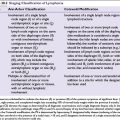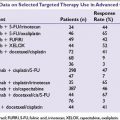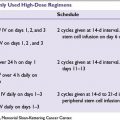STAGING
The American Joint Committee for Cancer/International Union Against Cancer (AJCC/UICC) staging classification of pancreatic cancer is the most widely used staging system. The practical importance of accurate staging is to discriminate between three categories: (1) operable or potentially operable disease; (2) inoperable but localized disease; and (3) metastatic disease. It is noted that in pancreatic cancer—unlike other solid tumors—stage III disease is by definition inoperable.
DIAGNOSIS
■Screening tests: There are no approved screening tests for pancreatic cancer.
■Tumor markers: CA 19-9 is the most useful and frequently measured tumor marker. However, it is relatively nonspecific, being elevated in the presence of jaundice and other upper GI cancers. In addition, between 10% and 30% of patients will never manifest an elevation in this marker. The CA 19-9 may have utility for surveillance following surgery or in the setting of advanced disease; however, changes or trends during treatment are complimentary to management and should not be used to alter therapy.
■Imaging techniques: Imaging techniques include chest radiographs, triphasic abdominal computerized tomography (CT) (with oral water contrast for enhanced imaging), ultrasound, endoscopic retrograde cholepancreatography (ERCP), and endoscopic ultrasound (EUS).
■EUS is excellent for tumor and nodal staging, and also for detecting the presence of portal vein invasion, although it is operator dependent. A major advantage of EUS is the ability to perform fine-needle aspiration (FNA). Hepatic lesions can also be visualized and potentially sampled.
■Pathologic diagnosis may be achieved with ERCP, laparoscopy, peritoneal cytology, or CT-guided biopsy.
MANAGEMENT
For the management of patients with pancreatic cancer the most important considerations relate to both the tumor stage and performance status of the patient. Following either surgical or radiological staging, the patient’s disease can be deemed (1) resectable or potentially resectable; (2) locally advanced, inoperable; or (3) metastatic.
Resectable Disease
Surgical removal of locally confined disease is the only realistic curative option. Even in that circumstance, however, the relapse rate is high such that surgical resection (with adjuvant chemotherapy) is viewed by many as deferring rather than eliminating recurrence. Less than 20% of patients with pancreatic cancer have disease that is considered resectable at diagnosis, meaning that the tumor is confined to the pancreas and not encasing the celiac axis or SMA and, at many institutions, not involving the superior mesenteric vein–portal vein confluence. A Whipple or modified, pylorus-sparing procedure is the surgical procedure of choice for pancreatic head tumors. The stomach (distal third), gallbladder, cystic and common bile ducts, duodenum, and proximal jejunum are resected, with resultant pancreatico-, choledocho-, and gastrojejunostomy. The peripancreatic, superior mesenteric, and hepatoduodenal lymph nodes are also staged. Pathologic review of the surgical margins must include assessment of the retroperitoneal margin (space directly adjacent to the proximal 3 to 4 cm of the SMA) by inking the margin and sectioning the tumor perpendicular to the margin. For tumors in the tail of the pancreas, distal pancreatectomy is performed.
Adjuvant chemotherapy: The current standard of care adjuvant chemotherapy for pancreatic cancer consists of either 5-fluorouracil (5-FU) or gemcitabine for 6 months. The major studies which have led to this are as follows:
–The ESPAC-1 trial (Neoptolemos et al. 2004) evaluated four groups of postsurgical patients treated with (1) surgery alone, (2) chemotherapy alone, (3) chemoradiation alone, or (4) chemoradiation followed by chemotherapy. The chemotherapy consisted of 5-FU/leucovorin and the median survival was 20.1 months (95% CI 16.5 to 22.7 months) for those who received chemotherapy and 15.5 months (95% CI 13.0 to 17.7 months) for those who did not receive chemotherapy (HR for death 0.71). Two-year and 5-year survival estimates were 40% and 21%, respectively, among patients who received chemotherapy compared to 30% and 8%, respectively, among patients who received no chemotherapy.
–The RTOG 9704 trial compared gemcitabine and 5-FU in a 442 patient study, all of whom also received adjuvant 5-FU-based chemoradiation. There was a suggested benefit to gemcitabine for patients with tumors in the head of the pancreas for whom the median and 3-year survival was 20.5 months and 31% respectively compared to 16.9 months and 22% in the fluorouracil group (HR 0.82; 95% CI 0.65 to 1.03; P = 0.09).
–The CONKO-1 study was a straightforward comparison of gemcitabine versus observation. Estimated disease-free survival at 3 and 5 years was 23.5% and 16.0% in the gemcitabine group versus 8.5% and 6.5% in the observation group, respectively. Gemcitabine significantly improved median overall survival (22.8 months vs. 20.2 months; P = 0.005). Estimated survival at 3 and 5 years was 36.5% and 21.0% for the gemcitabine-treated group compared to 19.5% and 9.0% for the observation group.
–The European Study Group for Pancreatic Cancer (ESPAC)-3 trial directly compared 5-FU and gemcitabine in resected disease and found that there was no difference in survival (23 months vs. 23.6 months; P = 0.39).
Adjuvant chemoradiation: The role of radiation postpancreatectomy is controversial given the systemic nature of the disease when it recurs. A potential role for radiation is argued for the high risk of locoregional recurrence and the attendant morbidity of this. The data are conflicting however and derive mainly from older studies:
–The Gastrointestinal Study Group (GITSG) trial randomized patients to chemoradiation with maintenance chemotherapy (n = 21) versus surgery alone (n = 22). The chemoradiation arm consisted of split-course 4,000 cGy radiation in combination with bolus 5-FU. The chemotherapy was subsequently administered for up to 2 additional years. A significantly prolonged median survival of 20 months for the patients treated with chemoradiation versus 11 months for controls was observed.
Stay updated, free articles. Join our Telegram channel

Full access? Get Clinical Tree






